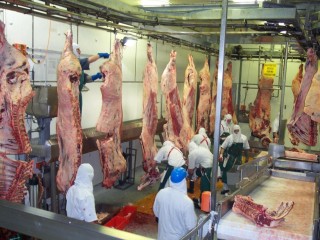 A combination of factors led by listless demand for Australian beef in Japan and the US, on the back of some big earlier weekly kills, has been blamed for a substantial drop in cattle slaughter rates last week.
A combination of factors led by listless demand for Australian beef in Japan and the US, on the back of some big earlier weekly kills, has been blamed for a substantial drop in cattle slaughter rates last week.
The NLRS national slaughter report issued this afternoon posted a national figure of 140,210 for the week ended Friday, down 5.5 percent on a week earlier when the kill hit a 2011 high of 148,451 head.
Declines were evident across the board, with every State registering reduced numbers.
Queensland’s kill declined by 6pc to 74,381 head, after shading 80,000 head a week earlier.
The NSW kill reached 36,518 head (-3pc); Victoria 17,886 (-6pc); South Australia 7158 (-9pc); and Tasmania 4267 (-2pc). Western Australian figures are not recorded by the NLRS service.
Export processors contacted this week pointed the finger squarely at the demand vacuum currently coming out of the US and Japan.
“We simply can’t sell meat into these major customer countries at present,” one processor contact said yesterday afternoon.
“There are major brokers, grinders and traders in the US that bought grinding beef earlier at big money, and the market has now dropped, meaning they can’t get liquidity to buy more beef,” he said.
“Some of those earlier deals were done at A$1.10 for 90CL imported beef, and it is now worth 90c. Equally, loin cuts are really hard to shift at present for the same reasons.”
JBS Australia’s Dinmore plant is understood to have dropped Thursday, Friday night and Saturday shifts last week. Teys Beenleigh is understood to be scheduling a ‘dark day’ on Wednesday this week. Other sites like Lakes Creek and Biloela are said to be day-to-day propositions at present.
“Nobody has picked this trade development. It’s come out of the blue,” one processor said.
“Part of the problem is also the earlier high weekly kills, on top of a Japan market that is looking sick, meaning there is nowhere to go. And the A$ doesn’t help. There’s no easy fix to this, and short kills might be the order of the day for the immediate future,” the contact said.
“For processors to get back to full kills would mean dropping the market further, and there’s too much feed out there across Eastern Australia for that to happen.”
Beef trade press in Japan yesterday reported further drops in wholesale price for imported beef due to slacking demand following the country’s recent natural disasters. Chilled US tenderloin dropped 4.8pc to Y2450/kg, and frozen Australian 90CL grinding beef dropped 5.5pc to Y510/kg over the last month.
The Japan Food Services Association last week said restaurant sales had declined a further 2.8pc in April compared to the same month last year, falling for the second month running. The slide reflected the ongoing impact of the Great East Japan Earthquake and Tsunami, and poor state of the Japanesde economy, now officially in recession.
Australian slaughter rates in southern areas are likely to be further affected by weather disruptions, following widespread rain across many regions starting on Sunday.
-
You can follow the weekly kill progression for 2010 and year-to-date 2011 on Beef Central’s ‘key indicators’ panel on the right-hand side of the home-page.
